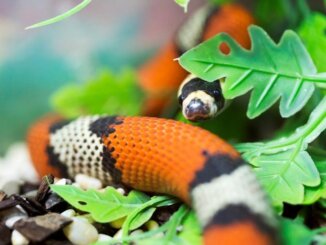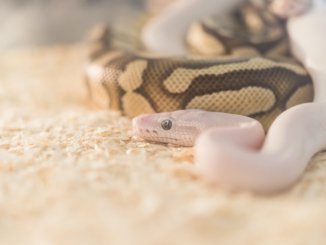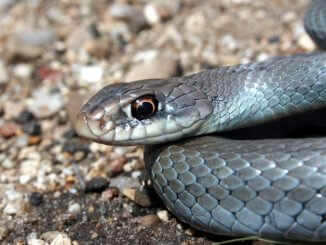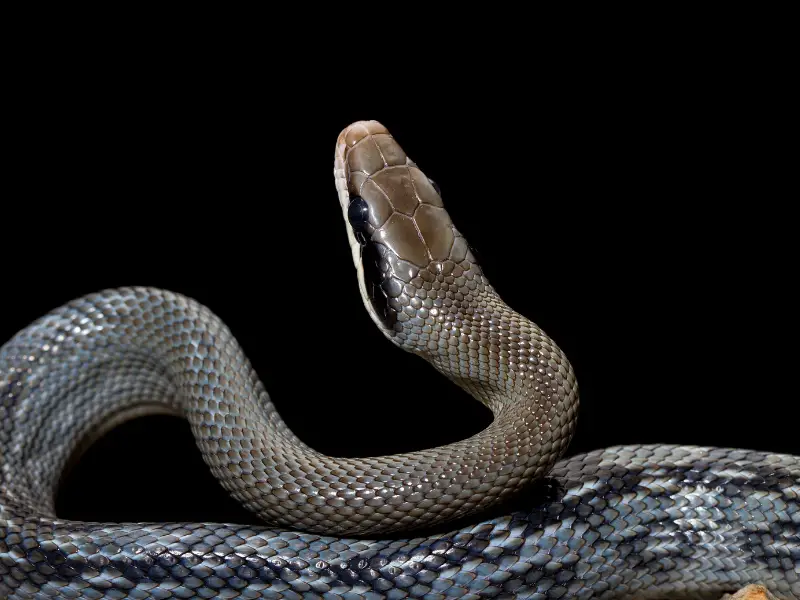
The blue beauty snake, also known as the Vietnam Blue Beauty, a sub-species of the Beauty Rat Snake, is a sight to see.
Collectors often praise them for their beautiful dark blue, steel blue, and sky blue coloring.
While you won’t find them naturally outside of eastern Asia, you should be able to get a blue beauty snake from a pet shop or reptile dealer.
Since they have a typically long lifespan, they make ideal pets for first-time snake owners if well cared for.
Blue Beauty Snake Overview
| Common name | Blue Beauty, Cave Racer, Vietnam Blue Beauty, Beauty Rat Snake |
| Scientific name | Orthriophis taeniura callicyanous |
| Natural habitat | The jungles of East and Southeast Asia. Semi-arboreal. |
| Adult size | 6 - 7 feet |
| Average lifespan | 15 - 25 years |
| Diet | Ground rodents like mice or rats |
| Housing | Vivarium (48” x 36”) |
| Experience | Beginner |
Origin
The blue beauty snake (Orthriophis taeniura callicyanous) is native to Vietnam, Cambodia, and Thailand. You can easily find them in various habitats, from agricultural fields to thick jungles.
As a semi-arboreal snake, it’s an agile climber, so any snake collector should ensure that the top of their vivarium remains closed.
According to the International Union for the Conservation of Nature (IUCN), the population of blue beauty snakes is currently unknown. Despite this, the IUCN classifies the species as Vulnerable.
Appearance And Behavior
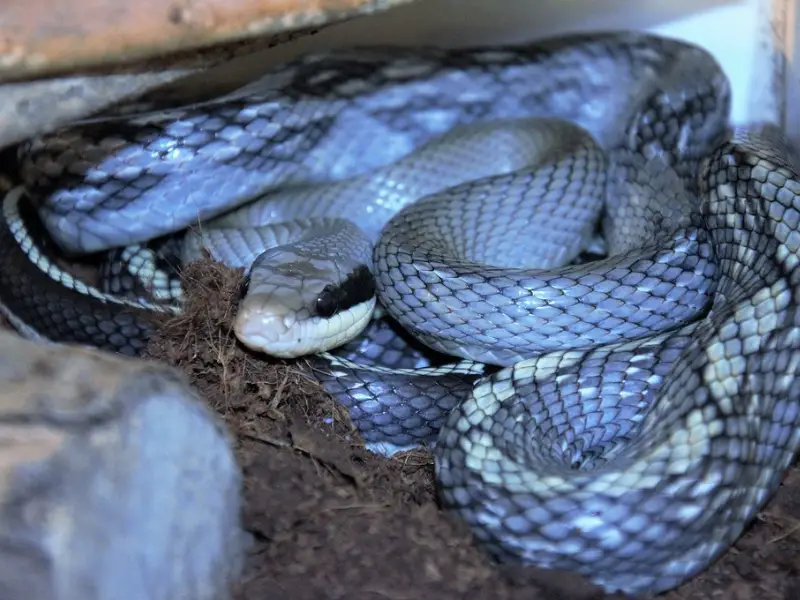
It’s relatively easy to recognize a blue beauty, thanks to its distinctive coloring.
They sport dark blue, metallic blue, or even sky blue coloring. Some can also boast an impressive band along the vertebral column. This band extends from the middle of the body to the tail.
The blue beauty has an elongated head. You’ll find dark or black horizontal stripes along the eyes. These features make the blue beauty a prize for serious collectors.
Unlike other snakes, the blue beauty rat snake is diurnal and nocturnal. This means that they are active both during the day and at night.
Size And Lifespan
Growing on average between 6 and 7 feet, the blue beauty requires a large vivarium. Some records indicate that the blue beauty can grow up to 8 or 9 feet long.
As a long-living snake, pet owners can expect their blue beauty to reach an age of 25 to 30 years.
Temperament
The blue beauty has a temperament that varies from snake to snake.
While some blue beauty snakes can be aggressive, most tend to be docile. However, remember that even a docile snake can quickly become aggressive. It’s best to avoid surprising the blue beauty or letting it feel threatened.
If a blue beauty feels threatened or cornered, it will shake its tail as a warning. While the blue beauty isn’t venomous, it can bite, which is typically quite painful.
Housing The Blue Beauty Snake
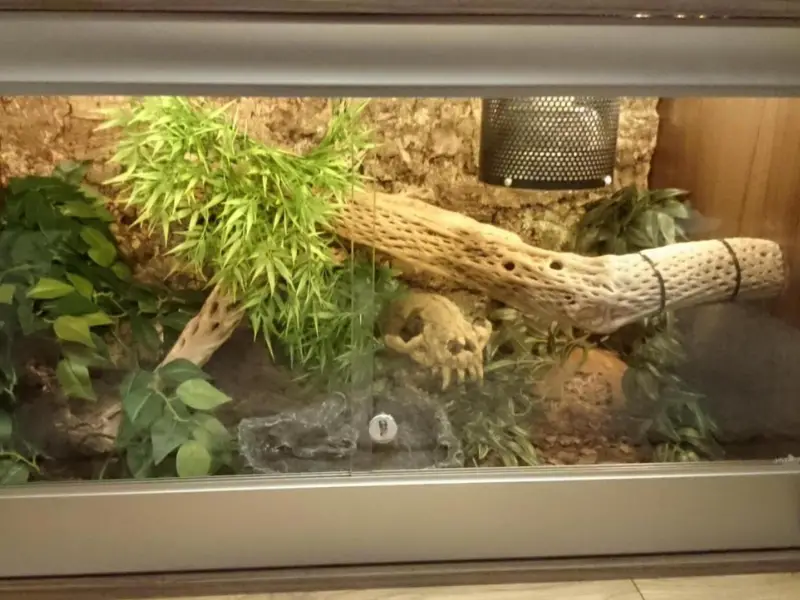
Since the blue beauty is native to the jungles of East and Southeast Asia, they prefer warm, humid vivariums.
The blue beauty requires a wooden vivarium. Wood is an excellent insulator and makes it easier to control the temperature and humidity inside the habitat.
While you can house your blue beauty in a glass vivarium, it’ll be tricky to maintain a constant temperature.
The enclosure also needs excellent air ventilation. Air should be able to flow in and out of the vivarium.
Enclosure Size
An enclosure for a blue beauty snake should be at least 48” long and 36” high. This large size is necessary because this species of snake can grow large and needs ample space.
Lighting
The blue beauty prefers warm weather, like most other reptiles. To help them regulate their temperature, install a basking light at one end of the vivarium.
Place several heat pads underneath the light, with a hide to heat this side of the enclosure. The heat pads should only cover half of the enclosure and only on the side where you’ll install the basking light.
Leave the heat pads on 24/7.
The basking light should be housed in a quality dome with ceramic housing that can tolerate the heat. Ensure you can easily switch the light on and off. The basking light shouldn’t be on for more than 12 hours daily.
Temperature And Humidity
The blue beauty prefers a constant, warm temperature of around 80 degrees Fahrenheit. On the warm, basking side of the vivarium, it should be around 85 – 88°F. The cool side should sit between 75 – 80°F.
At night, the cooler side of your enclosure can drop to approximately 72°F.
To maintain the enclosure’s temperature at night, opt for a ceramic night bulb.
The ceramic bulb will maintain the temperature at 80 degrees but won’t produce any light.
Ensure that the night bulb is protected by a bulb guard and connected to a quality thermostat. The thermostat and night bulb will work together to ensure the temperature stays at 80 degrees.
Maintain a humidity level between 70-80%. You can use a hand mister or an automatic one, depending on your preference.
Substrate And Decoration
The blue beauty prefers a relatively dry substrate, such as beech wood chips. You’ll find it’s relatively easy to clean, and the blue beauty will enjoy the humidity that the beech wood chips maintain.
Since the blue beauty is semi-arboreal, they enjoy things to climb on. Decorate the vivarium with pieces of wood to climb on. Add some more decorations, like artificial plants, for a natural habitat.
Cleaning
Pet owners will need to clean the blue beauty’s vivarium monthly. Once a month is typically enough.
When you clean the enclosure, be sure to disinfect it and change out the bedding. You can use a reptile-safe cleaning product or vinegar and water to clean the enclosure properly.
Blue Beauty Snake Care
The blue beauty is a hardy snake and is relatively easy to care for. If you look after your blue beauty, you can expect it to live a long, happy life of up to 30 years.
Food And Water
If you have a blue beauty hatchling, you should feed it only once a week. Defrost a pinky mouse and feed it to the hatchling.
As your snake grows older and its size increases, you should gradually increase the size of its food.
An adult blue beauty only eats once every two weeks. Try to stick to this or they can quickly become overweight.
You must also add a water bowl to your vivarium. The water bowl should be large enough for the snake to get into.
Handling
You should handle your blue beauty regularly to ensure it stays tame. The blue beauty is an active, curious snake that enjoys new experiences. Regular handling will ensure it stays happy and well-socialized.
Allow your blue beauty to anchor itself by wrapping a tail around your wrist or arm. This anchor will help keep them calm and confident.
When handling your blue beauty, keep a firm but gentle hold of it. This hold will also help when you remove or place it back in its enclosure.
Common Health Issues
Your blue beauty can experience a variety of common illnesses, including:
- Abscesses. Caused by bacteria, abscesses appear as lumps under the skin of the snake. To treat an abscess, you’ll need to take your snake to a vet. They will drain the abscess and may prescribe antibiotic treatment.
- Blister disease. Fluid-filled blisters form on the underside of your snake due to a dirty environment. If too many blisters form, it can be life-threatening. To treat the blisters, it’s best to consult a veterinarian. You’ll need to quarantine your snake and apply antibiotic ointment to the affected areas.
- Internal parasites. Parasites can come from food and can cause your snake to feel unwell, lose its appetite or regurgitate food. A reptile vet may recommend worm treatment or a prescription medication to treat parasites.
- Respiratory illnesses. If you notice your snake wheezing or making noises when breathing, it may have a respiratory infection. This is generally caused by an inadequate enclosure environment.
- Inclusion Body Disease (IBD). IBD is a very serious, viral disease that can affect blue beauty snakes. If you notice regurgitation or neurological symptoms (head shaking, asymmetrical pupil dilation, and stargazing), isolate your snake immediately and contact a reptile vet.
Breeding
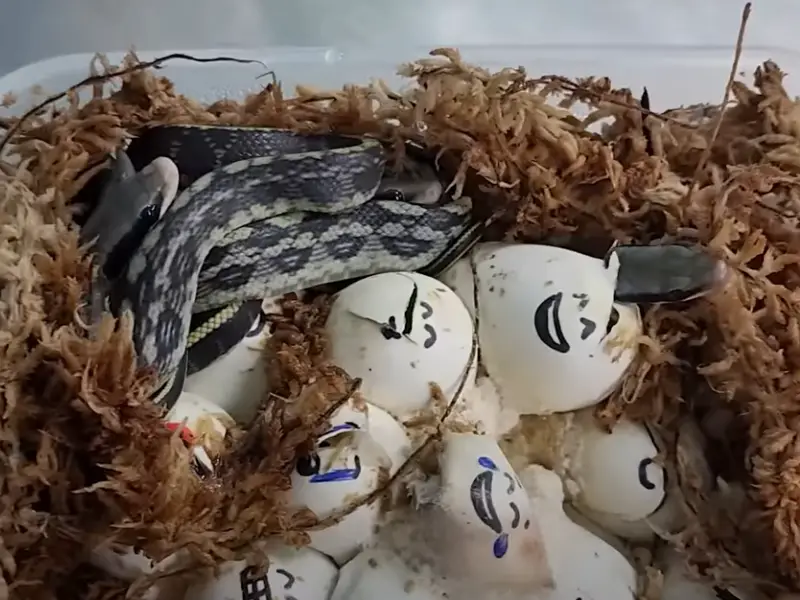
Eager pet owners can keep a male and female blue beauty together in the same vivarium. Without any encouragement, they may start breeding. Your only concern will be ensuring that the vivarium conditions stay healthy.
A gravid blue beauty female should have access to a nesting box. Ensure the nesting box is large enough for the female to turn around. Add some moss to keep the temperature inside the nesting box moist and humid.
Once the female has laid the eggs, you should incubate them at 84 degrees. The eggs should start hatching after 60 days. As soon as the first hatchlings leave their eggs, the other eggs will also begin to hatch.
Choosing And Buying A Blue Beauty Snake
The blue beauty is an easy animal to keep as a pet. Their stunning coloration and inquisitive, docile nature make them fun to handle.
When buying a blue beauty snake, make sure you choose a reputable breeder. The average blue beauty costs around $450 to $500. Depending on the pet shop, or importer, they may cost more.
When buying a blue beauty, look out for the following:
- Its eyes should be crystal clear.
- The mouth and nose should be free of discharge.
- Its body should be round and full.
- The snake should be alert and active.
If your snake has all the signs mentioned above, you can better trust that you’re buying a healthy blue beauty.
For more beginner-friendly pet snakes, check out our guide to 20 friendly pet snakes!

